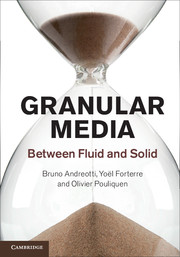3 - The granular solid: statics and elasticity
Published online by Cambridge University Press: 05 June 2013
Summary
A granular medium without external perturbation can be considered primarily as a solid. A pile of sand, the soil on which a house is built and a silo filled with grains are examples of situations in which the grains do not move. The material supports external forces without flowing, just like a solid. This chapter is dedicated to the statics of granular media: how are grains organized in a packing? Howare the forces distributed among the particles to ensure the mechanical balance of the pile? Is it possible to describe the granular medium as a continuum and to define stresses? The chapter starts with the description of the geometrical properties of packings by introducing the concepts of volume fraction and compaction of a granular medium (Section 3.1). Then the problem of the mechanical equilibrium of a sand pile is addressed, and the statistical properties of the inter-particle force distribution are presented (Section 3.2). Following the analysis at the microscopic level, the possibility of a continuum description is discussed in Section 3.3. The concept of stresses in granular media and the relation between inter-particle forces and macroscopic stresses are presented. Simple cases for which the stress distribution can be calculated are studied (Section 3.4). Finally, the issue of elasticity and sound propagation in a granular packing is discussed in Section 3.5.
Granular packings
Packings of grains have been studied since antiquity. Mathematicians, physicists and engineers, in a quest to optimize the storage of granular matter, have been interested in these issues. This section is an introduction to the concepts which are useful for characterizing packings of grains. For more details, the reader is referred to more specialized works, such as the book by Cumberland and Crawford (1987).
- Type
- Chapter
- Information
- Granular MediaBetween Fluid and Solid, pp. 59 - 121Publisher: Cambridge University PressPrint publication year: 2013



